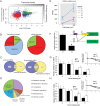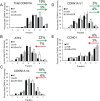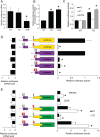Translational control of a human CDKN1A mRNA splice variant regulates the fate of UVB-irradiated human keratinocytes
- PMID: 29118075
- PMCID: PMC5746064
- DOI: 10.1091/mbc.E17-06-0362
Translational control of a human CDKN1A mRNA splice variant regulates the fate of UVB-irradiated human keratinocytes
Abstract
In response to sublethal ultraviolet B (UVB) irradiation, human keratinocytes transiently block progression of the cell cycle to allow ample time for DNA repair and cell fate determination. These cellular activities are important for avoiding the initiation of carcinogenesis in skin. Central to these processes is the repression of initiation of mRNA translation through GCN2 phosphorylation of eIF2α (eIF2α-P). Concurrent with reduced global protein synthesis, eIF2α-P and the accompanying integrated stress response (ISR) selectively enhance translation of mRNAs involved in stress adaptation. In this study, we elucidated a mechanism for eIF2α-P cytoprotection in response to UVB in human keratinocytes. Loss of eIF2α-P induced by UVB diminished G1 arrest, DNA repair, and cellular senescence coincident with enhanced cell death in human keratinocytes. Genome-wide analysis of translation revealed that the mechanism for these critical adaptive responses by eIF2α-P involved induced expression of CDKN1A encoding the p21 (CIP1/WAF1) protein. We further show that human CDKN1A mRNA splice variant 4 is preferentially translated following stress-induced eIF2α-P by a mechanism mediated in part by upstream ORFs situated in the 5'-leader of CDKN1A mRNA. We conclude that eIF2α-P is cytoprotective in response to UVB by a mechanism featuring translation of a specific splice variant of CDKN1A that facilitates G1 arrest and subsequent DNA repair.
© 2018 Collier et al. This article is distributed by The American Society for Cell Biology under license from the author(s). Two months after publication it is available to the public under an Attribution–Noncommercial–Share Alike 3.0 Unported Creative Commons License (http://creativecommons.org/licenses/by-nc-sa/3.0).
Figures






References
-
- Boyce M, Bryant KF, Jousse C, Long K, Harding HP, Scheuner D, Kaufman RJ, Ma D, Coen DM, Ron D, Yuan J. A selective inhibitor of eIF2alpha dephosphorylation protects cells from ER stress. Science. 2005;307:935–939. - PubMed
-
- Brugarolas J, Chandrasekaran C, Gordon JI, Beach D, Jacks T, Hannon GJ. Radiation-induced cell cycle arrest compromised by p21 deficiency. Nature. 1995;377:552–557. - PubMed
Publication types
MeSH terms
Substances
Grants and funding
LinkOut - more resources
Full Text Sources
Other Literature Sources
Molecular Biology Databases

